
John
Bown: In His Own Words
Activity
1: John Brown's Letters
Read
the letter from John Brown to Henry
Stearns, July 15, 1857
Read
John Brown Letters from Kansas
http://www.hudson.lib.oh.us/hudson%20website/Archives/Archives/
john%20brown/john_brownletters.htm
To
read the letters, double click on each letter; wait a few moments
until a button appears in the lower right hand corner of the
letter; click on the button to expand the letters to readable
size.
Questions
to ask:
1.
What do these letters tell us about John Brown’s personality
and his attitudes toward his family?
2.
What do these letters reveal about his motives for going to
Kansas, his opinion of the pro-slavery forces in Kansas, his
optimism or pessimism about the future of anti-slavery in Kansas,
and his attitude toward violence?
Activity
2: John Brown in Art
How
have artists and photographers portrayed John Brown?
| |
|
|
|
| |
John
Brown
(before acquisition of beard which typifies him as the stormy
prophet of emancipation).
(circa 1850)
Copy
of daguerreotype,
National Archives and Records Administration
|
John
Brown
bust-length ,
ca. 1856
Engraving from daguerreotype,
National
Archives and Records Administration
|
John
Brown
Photograph by Black and Bachelder. (1859)
Library of Congress. |
| |
|
|
|
Lithograph
of John Brown
circa 1859)
three-quarter length portrait, facing left, holding New
York Tribune, Library of Congress
|
John
Brown,
head-and-shoulders portrait, facing slightly right
Library of Congress.
Inscribed on print: Mrs. Hellen Brodt painted 1864. |
|
|
| |
|
|
|
| |
|
|
|
| |
|
|
|
| |
The
Legend of John Brown,
( 1941)
Jacob Lawrence
gouache |
Picture
of John Brown
(1943)
In the frontspiece of John Brown 1800-1859: A Biography
Fifty Years After by Villard. |
Trial
of John Brown
Sketched by Porte Crayon, reproduced from Leslie's Illustrated
Weekly. Brown is pictured lying on a stretcher, still
recovering from the sword wound inflicted by Israel Green. |
Questions
to ask:
1.
Compare and contrast the various ways that artists have depicted
John Brown.
2.
Explain why these artists may have depicted John Brown in different
ways.
Activity
3: How was John Brown depicted in contemporary newspapers?
Resource
1: Sesssion Era Editorials
http://history.furman.edu/~benson/docs/jbmenu.htm
Albany,
New York Evening Journal [Republican], 18 October 1859
The telegraph during the past twenty-four hours has brought
startling accounts of an "insurrection" at Harper's
Ferry.
Charleston,
South Carolina Mercury [Democratic], 18 October 1859
Our despatches this morning give us some particulars of a serious
outbreak among the employees on the government works at Harper's
Ferry, Virginia
Richmond,
Virginia Whig [Opposition], 18 October 1859
There is at least no cause for uneasiness elsewhere in the State,
notwithstanding the reports concerning the complicity of the
negroes in the business.
Albany,
New York Evening Journal [Republican], 19 October 1859
The leader of the conspiracy is stated to be Captain BROWN,
of Kansas notoriety. This fact affords an explanation of some
points in it otherwise inexplicable.
Resource
2: Valley of the Shadow Project
Staughton
(Virginia) Spectator
http://www.iath.virginia.edu/jbrown/spectator.html#10/18
- October
18, 1859
- November
1, 1859
- November
8, 1859
|
- November
22, 1859
- December
6, 1859
- December
20, 1859
|
The
Valley Spirit (Chambersburg, Pennsylvania)
http://www.iath.virginia.edu/jbrown/spirit.html#8/24
- August
24, 1859
- October
26, 1859
- November
2, 1859
- November
9, 1859
|
- November
23, 1859
- December
7, 1859
- December
21, 1859
|
Questions
to ask:
- How
do these accounts differ?
- How
are these accounts similar?
- Why
are they different?
Activity
4: :
John Brown in Song
A
search on the phrase, John Brown, at the Library of Congress'
online exhibit, America
Singing: Nineteenth-Century Song Sheets, produces songs
that condemn and celebrate his actions.
 |
The
song, "The Fright of Old Virginia," provides
a sympathetic account of the raid and Brown's fate with
the chorus:
"Virginia
is the state, you know,
That never feared a mortal foe;
But chivalry was rather low,
When Brown came to Old Virginia."
Read
a transcription
Enlarge
image
|
Library
of Congress |
|
"John
Brown" echoes the sentiment by describing Brown as
both a "hero, and a martyr" who "bled for
the colored race . . . [and] longed to set them free."
Read
a transcription
Enlarge
image
|
Library
of Congress |
| |
On
the other hand, songs such as "John Brown's Entrance
Into Hell," imagines Brown's final destination celebrated
by Satan.
"John
at my left, Abe at my right,
We'll give the heavenly hosts a fight....;
Abe's Cabinet, 'tis very true,
Will soon knock here as loud as you--
In short, the negroizing clan,
Are traveling here unto a man."
Read
a transcription
Enlarge
image
|
| Library
of Congress |
Questions
to ask:
- What
words do songs that support John Brown use?
- What
words do songs that condemn John Brown use?
- Do
you think that any of these songs provide an objective account
of John Brown's actions?
- What
are the specific targets of the songwriters' support or hatred?
- How
do these songs comment on both John Brown and the general
issue of slavery?
- Do
you think that such songs might influence how John Brown is
remembered in both the history books and in public memory?
These
questions were developed by the Library of Congress.
(http://memory.loc.gov/learn/collections/amsing/thinking.html)
|
